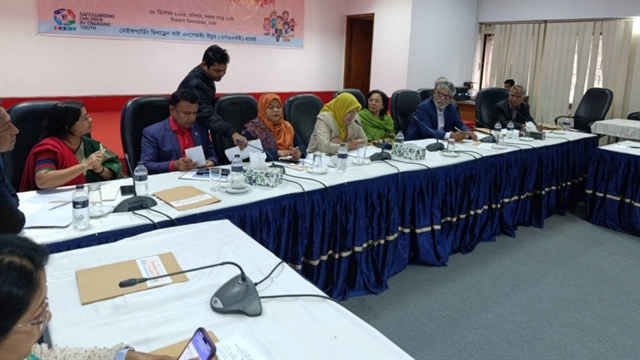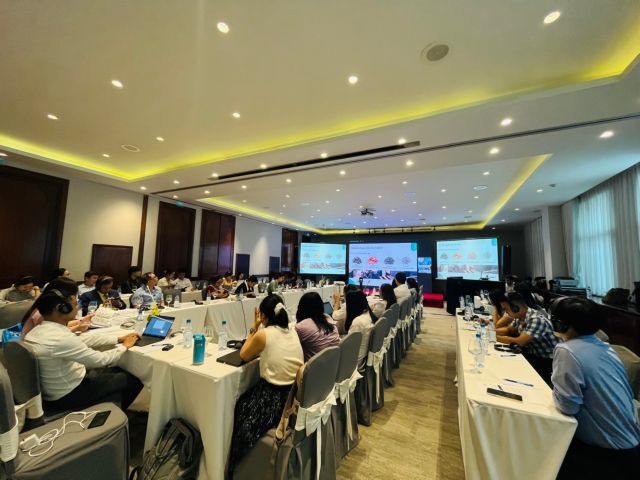 Economy
Economy

 |
| Participants at the workshop on Extended Producer Responsibility (EPR) on E-Waste on Tuesday in Ha Noi. — Photo courtesy of IFC |
by Mai Hương
HÀ NỘI — A number of businesses and industry associations shared their feedback on the draft Decision regarding recycling costs determination proposed by the Ministry of Natural Resources and Environment (MONRE) at a workshop on Extended Producer Responsibility (EPR) on E-Waste on Tuesday in Hà Nội.
Electronic waste, or e-waste, describes discarded electronic devices.
The proposed Decision outlines a reasonable and valid recycling costs norm for a unit volume of products and packages (Fs), administrative cost of management, supervision and support to perform the waste collection and recycling responsibilities of manufacturers and importers.
The Law on Environmental Protection 2020 and Government Decree No. 08/2022 require manufacturers and importers of certain products and packages to take responsibility for recycling and treatment based on mandatory recycling rates and specifications.
“EPR follows the principle the polluter has to pay. Manufacturers bring products and packages to the market, and after consumption, they become waste that they must be responsible for recycling,” said Nguyễn Thi, MONRE’s senior legal expert.
Organisations and individuals involved in manufacturing or importing products and packages with recycling value can either recycle themselves or contribute financially to Việt Nam's Environmental Protection Fund to support recycling efforts.
According to the draft Decision, manufacturers and importers of products like batteries, accumulators, tyres, lubricants, and packages for food, cosmetics, drugs, fertilisers, animal feed, detergents, and commercial cement will be responsible for recycling costs starting from January 1, 2024. Electrical and electronic products will be included from January 1, 2025, and vehicle products from January 1, 2027.
E-waste in Việt Nam is rapidly increasing, but proper recycling and appropriate recycling infrastructure are lacking. The introduction of EPR is expected to encourage the establishment and development of collection and recycling infrastructure in the country, although this process will take time to yield visible results.
Nguyễn Đức Quảng, Deputy Director of the Institute of Environmental Science and Technology, representative of the Consultant Group (DHBK), said the draft Decision has for the first time provided a list of waste products and packaging with norms of recycling costs for each product group. Along with that, it has formalised the adjustment factor, an important component in the rational calculation of the recycling cost norm.
High Fs controversy
However, there are concerns among enterprises and associations regarding the high recycling costs (Fs), which could create a significant financial burden for their businesses and potentially lead to increased product prices for consumers.
Representatives from Samsung Vietnam pointed out that the fee levels should be compared to those of other countries, suggesting that the difference should be around 100 per cent, while the draft indicates a difference of 200 per cent or more.
Panasonic raised similar concerns, stating that with the proposed Fs, the company would have to pay around VNĐ40-50 billion annually for recycling fees, which account for about 5-7 per cent of the product prices.
The discrepancy in recycling costs for different products was also highlighted, with mobile phones having a recycling cost proposed to be five times higher than that of light bulbs, despite mobile phones having higher intrinsic material value.
Dr. Bernd Kopacek, an International Expert from the International Finance Corporation (IFC), pointed out that the recycling cost norms for electrical and electronic devices primarily focus on dismantling and recycling iron, aluminium, copper, and glass, while ignoring the recycling of other parts and the treatment of hazardous substances. He emphasised the need to consider the costs of treating hazardous substances and the revenues from precious metals. He also noted that the current approach would make it difficult for the formal sector to compete with informal collectors who pay for scrap.
According to the draft Fs, the financial contribution and funding support for recycling discarded products and packaging is determined by volume (kilogramme) for the group of electrical and electronic products. Followingly, refrigeration equipment has an Fs of VNĐ9,399/kg recycled, fixed and portable air conditioners VNĐ12,746/kg, monitors and devices containing displays VNĐ13,230/kg, mobile phone VNĐ27,656, and fluorescent light bulbs VNĐ6,438/kg.
In response to these concerns, Nguyễn Đức Quảng, Deputy Director of the Institute of Environmental Science and Technology, explained that different electrical and electronic products have different recycling costs (Fs) based on the recycling technology used, the amount of recovered material, and the value of the material. Efficiently recycled products will have lower Fs, while products that haven't been effectively recycled in Việt Nam will have higher Fs.
Quảng further stated that the draft decision focuses on dismantling, but for some products like TV screens and fluorescent light bulbs, Việt Nam lacks treatment technology due to the hazardous waste they contain. Therefore, the consultant group proposed including additional criteria such as material recovery rates and the presence of hazardous or unrecoverable materials.
Quảng also added recent surveys supported by the International Finance Corporation (IFC) revealed that existing recycling facilities in Việt Nam are treating e-waste as hazardous waste rather than a valuable resource. Many treatment processes only involve manual demolition and hazardous waste treatment through curing and destruction.
“This will be an obstacle in Việt Nam's efforts to develop the recycling industry in the future, so the EPR system is expected to be a system that allows us to develop a technology other than the current e-waste treatment technology.”
Meanwhile, Hứa Phú Doãn, Vice President of the Vietnam Waste Recycling Association, suggested that the recycling cost should include investment costs in waste treatment technology to incentivise private enterprises to develop the waste treatment industry in Việt Nam.
Recently, 14 business associations submitted proposals to MONRE, requesting a reduction in recycling costs. They argued that the Fs is based on insufficient data and doesn't consider the value of recovered products in line with the principles of the circular economy. — VNS




